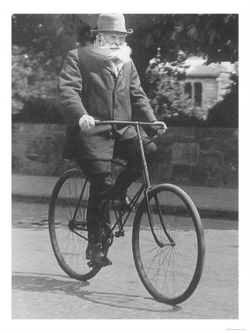Tire
A comprehensive overview of tires, their history, types, and applications
Tire[edit]
A tire (or tyre) is a ring-shaped component that surrounds a wheel's rim to transfer a vehicle's load from the axle through the wheel to the ground and to provide traction on the surface traveled over. Most tires, such as those for automobiles and bicycles, are pneumatically inflated structures, which also provide a flexible cushion that absorbs shock as the tire rolls over rough features on the surface.

History[edit]
The development of tires has been a significant factor in the evolution of transportation. The first tires were bands of leather, then iron (later steel) placed on wooden wheels used on carts and wagons. The invention of the pneumatic tire is credited to John Boyd Dunlop, who developed it in 1887 for his son's tricycle.

Construction[edit]
Modern tires are made from synthetic rubber, natural rubber, fabric, and wire, along with carbon black and other chemical compounds. They consist of a tread and a body. The tread provides traction while the body provides containment for a quantity of compressed air.
Components[edit]
- Tread: The part of the tire that comes in contact with the road. It is designed to provide traction and resist wear.
- Sidewall: The side of the tire, which provides lateral stability.
- Bead: A loop of high-strength steel cable coated with rubber, which ensures an airtight fit with the wheel.
- Plies: Layers of fabric that make up the body of the tire. They provide strength and flexibility.

Types of Tires[edit]
Tires are classified into several types based on their application and construction.
Passenger Vehicle Tires[edit]
These are designed for use on cars and light trucks. They are optimized for comfort, fuel efficiency, and durability.
Truck and Bus Tires[edit]
These tires are designed to carry heavy loads and are built to withstand the rigors of long-distance travel.

Off-the-Road Tires[edit]
Used for construction vehicles, mining equipment, and other heavy-duty applications. They are designed to handle rough terrain and heavy loads.
Aircraft Tires[edit]
These are designed to withstand the extreme forces of landing and takeoff. They are built to be lightweight yet strong.

Winter Tires[edit]
Winter tires are designed to provide better traction on snow and ice. They come in two main types: studded and studless.


Performance and Safety[edit]
Tires play a crucial role in the safety and performance of a vehicle. Proper tire maintenance, including regular inflation checks and tread inspections, is essential for safe driving.
Related Pages[edit]
Ad. Transform your life with W8MD's Budget GLP-1 injections from $75


W8MD offers a medical weight loss program to lose weight in Philadelphia. Our physician-supervised medical weight loss provides:
- Weight loss injections in NYC (generic and brand names):
- Zepbound / Mounjaro, Wegovy / Ozempic, Saxenda
- Most insurances accepted or discounted self-pay rates. We will obtain insurance prior authorizations if needed.
- Generic GLP1 weight loss injections from $75 for the starting dose.
- Also offer prescription weight loss medications including Phentermine, Qsymia, Diethylpropion, Contrave etc.
NYC weight loss doctor appointmentsNYC weight loss doctor appointments
Start your NYC weight loss journey today at our NYC medical weight loss and Philadelphia medical weight loss clinics.
- Call 718-946-5500 to lose weight in NYC or for medical weight loss in Philadelphia 215-676-2334.
- Tags:NYC medical weight loss, Philadelphia lose weight Zepbound NYC, Budget GLP1 weight loss injections, Wegovy Philadelphia, Wegovy NYC, Philadelphia medical weight loss, Brookly weight loss and Wegovy NYC
|
WikiMD's Wellness Encyclopedia |
| Let Food Be Thy Medicine Medicine Thy Food - Hippocrates |
Medical Disclaimer: WikiMD is not a substitute for professional medical advice. The information on WikiMD is provided as an information resource only, may be incorrect, outdated or misleading, and is not to be used or relied on for any diagnostic or treatment purposes. Please consult your health care provider before making any healthcare decisions or for guidance about a specific medical condition. WikiMD expressly disclaims responsibility, and shall have no liability, for any damages, loss, injury, or liability whatsoever suffered as a result of your reliance on the information contained in this site. By visiting this site you agree to the foregoing terms and conditions, which may from time to time be changed or supplemented by WikiMD. If you do not agree to the foregoing terms and conditions, you should not enter or use this site. See full disclaimer.
Credits:Most images are courtesy of Wikimedia commons, and templates, categories Wikipedia, licensed under CC BY SA or similar.
Translate this page: - East Asian
中文,
日本,
한국어,
South Asian
हिन्दी,
தமிழ்,
తెలుగు,
Urdu,
ಕನ್ನಡ,
Southeast Asian
Indonesian,
Vietnamese,
Thai,
မြန်မာဘာသာ,
বাংলা
European
español,
Deutsch,
français,
Greek,
português do Brasil,
polski,
română,
русский,
Nederlands,
norsk,
svenska,
suomi,
Italian
Middle Eastern & African
عربى,
Turkish,
Persian,
Hebrew,
Afrikaans,
isiZulu,
Kiswahili,
Other
Bulgarian,
Hungarian,
Czech,
Swedish,
മലയാളം,
मराठी,
ਪੰਜਾਬੀ,
ગુજરાતી,
Portuguese,
Ukrainian